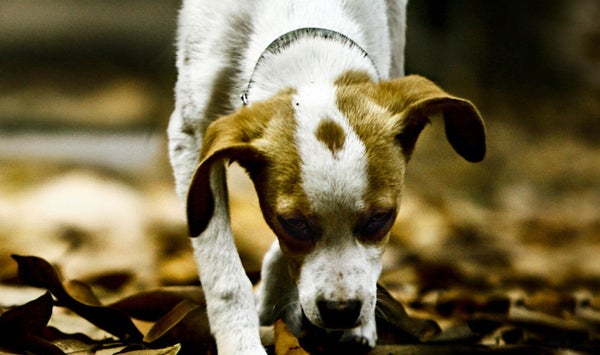This article was published in Scientific American’s former blog network and reflects the views of the author, not necessarily those of Scientific American
"Pee," I inform my walking companion, who frowns in agreement. "I think it's human."
"And that's dog pee," I offer confidently a while later.
It was a hot summer day in Manhattan, and, as any New Yorker knows, I was observing the obvious. You may not broadcast your nasal discoveries, but that doesn't mean they aren’t there. You notice skunk and car exhaust without needing to see them, and your nose is to blame (at least mine is) when I order french fries at a diner after smelling the Potato God brought to a nearby table.
On supporting science journalism
If you're enjoying this article, consider supporting our award-winning journalism by subscribing. By purchasing a subscription you are helping to ensure the future of impactful stories about the discoveries and ideas shaping our world today.
Which is to say, we all have noses! Not that we pay them much mind, though. We spend most of our time in our visual worlds and are even likely to focus on the visual aspects of the nose (think rhinoplasty) rather than dwell on its inner workings.
So it shouldn't surprise anyone that it takes a dog's nose to invigorate the spirit of all noses, which is where Alexandra Horowitzcomes in. Horowitz (Facebook, Twitter) is well-known for the New York Times bestseller "Inside of a Dog: What Dogs See, Smell, and Know," and How do dogs "see" with their noses?—a highly-viewed TED-Ed video. On a personal note, I was lucky enough to work with her as Lab Manager at the Horowitz Dog Cognition Lab at Barnard College for a number of years.
Her latest book, "Being a Dog: Following the Dog into a World of Smell," out this month, kicks off with the dog's nose but does not leave ours in the dust. It can't. Smell is a two-way street in our relationship with dogs. It is your smell that rats you out when your dog greets you. And you too know your dog's smell, demonstrates Horowitz, when she tests whether she can identify—only by smell!—where each of her dogs had been sitting on the couch. You most likely can pull off this parlor trick too, research suggests. The design and execution of the dog nose is a marvel, we learn. Each nostril can attend to different types of odors, there's a "second nose" not accessed via sniffs, and even dog exhalations are fancy and exit via side slits, "allowing dogs to get a continuous read of the world—just in the way that we see the world without pauses while we blink," explains Horowitz.
And while you've probably heard that dogs have great sniffers, Horowitz gets into the nuances of this rather flat statement. A visit to the Penn Vet Working Dog Center reveals the making of detection dogs—be it a nose for death, disease, or dope—and Horowitz meets other dogs who fixate on scat or truffles (no, 'scat detection' does not refer to the many dogs who find and dine on poop; instead, scat detection dogs, like those at Conservation Canines, learn to find the scat of wild animals, which aids wildlife biologists and conservationists in their work). These 'dogs on scent' are the noses we celebrate. It wouldn't surprise me if one day we make a national holiday out of it.
Then there are The Others, companion dogs at the smell-mercy of their humans, observes Horowitz. "Many live in owner-controlled smell environments, asked to do little smelling beyond locating and cleaning up any food the resident child has dropped from his high chair." But dogs—regardless of whether they are involved in detection or companionship—live life nose-first. With her own dogs Finnegan and Upton as guides, Horowitz explores what it's like to be a being of the nose and considers ways to embrace their sensorium. She adds perspective and explanation for those dog proclivities that can be difficult for us humans to appreciate—urine, another dog's rear end, garbage. The good news is, you don't have to personally like it to embrace it.
I often hear that readers of Horowitz's first book, "Inside of a Dog," now accompany their dogs on "smell walks" where the dog's nose leads the way. "Being a Dog" readers will carry with them an appreciation for nose work, whether attending classes as Horowitz did with Finnegan, or setting up nose games at home. "The sport of 'nosework' makes a game out of what to working dogs is their occupation: simply using their noses to find something hidden—the 'hides.'"
Then there's us. The human nose is no less interesting than that of the dog; it is just different. Our nose is a window into our memories, our food, and the stinky armpit jammed in our face on the subway. Horowitz works her nose: she moves past labels of good (like nachos) and bad (like stinky armpits) to notice smells, sometimes finding her way to the source, but always altering the color and texture of experiences. She tries to smell what her dogs attend to on a walk, she ventures out on a smell walk (specifically for humans!), she tracks smells, and she participates in smell research. Simply "bothering to attend to smells" opens up a new dimension that brings us closer to the worldview of the dog.
Dogs and humans will never be one and the same. We wait for our noses to bring to us; we don’t typically go out and gather. In this way, we are constitutionally different from dogs who vie for scents, are on top of them, are just. trying. to get. a little. bit. more. Despite the immense differences between our two species, we value the heck out of one another. If part of love is understanding, I'm going all in on smell.
